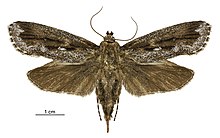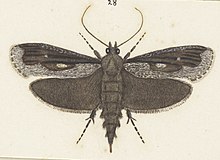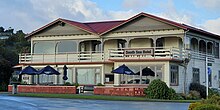
Bascantis is a genus of moths belonging to the family Tineidae. It contains only one species, Bascantis sirenica, that is endemic to New Zealand. This species is classified as "Data Deficient" by the Department of Conservation.

Izatha psychra is a species of moth in the family Oecophoridae. It is endemic to New Zealand. It is classified as Nationally Endangered by the Department of Conservation. In 2020 it was feared that this moth was extinct as a result of a fire at the Pukaki Scientific Reserve, the last known locality of this species. However a 2021 survey found I. psychra present in the small portion of the reserve that was not damaged by the fire.

Izatha caustopa is a lichen tuft moth in the family Oecophoridae. It is endemic to New Zealand, where it is known very locally, and very infrequently, from the southern half of the North Island: two specimens collected in 2016 were the first seen for 30 years. It is classified as "Data Deficient" by the Department of Conservation.
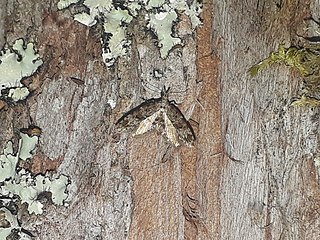
Isonomeutis restincta, the marbled snouter, is a species of moth in the family Copromorphidae. It is endemic to New Zealand where it is likely found in the northern parts of the North Island. Not much is known of the life history of this species but it has been hypothesised that it is a scale insect predator. The adults of this species are on the wing from November to January. This species has been classified as "At Risk, Naturally Uncommon" by the Department of Conservation.

Circoxena ditrocha is a species of moth in the family Blastodacnidae. This species is endemic to New Zealand and has been collected on both the North and South Islands. The habitat of this species is on the edges of native forest or scrub and it may be associated withPseudopanax arboreus. As at 2000 the host species of this moth is unknown but it has been hypothesised that the larvae are seed borers. Adults are on the wing in December to March. It is classified as "At Risk, Naturally Uncommon" by the Department of Conservation.

Schiffermuelleria orthophanes is a moth of the family Oecophoridae. It is endemic to New Zealand. It is classified as critically endangered by the Department of Conservation.
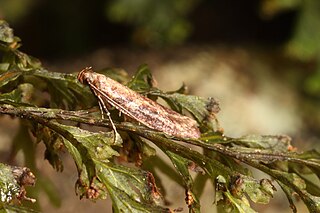
Cadmogenes is a genus of moths of the family Plutellidae. It contains only one species, Cadmogenes literata, which is found in New Zealand. This species is endemic to New Zealand. It has been classified as "Not Threatened" by the Department of Conservation.
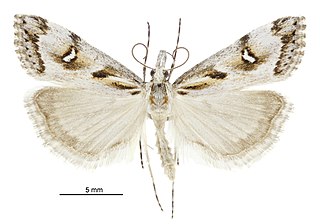
Gadira leucophthalma, the beaked moss moth, is a moth in the family Crambidae. It is endemic to New Zealand. It is found in the south eastern side of the South Island down to Banks Peninsula. G. leucophthalma inhabits the foredunes of coastal areas. The larval host is unknown but it has been hypothesised that the larvae feed on moss. The adult moths are day flying although some specimens have been trapped at night via light traps. Adults are commonly on the wing from March to April. This species has been classified as Nationally Vulnerable by the Department of Conservation.
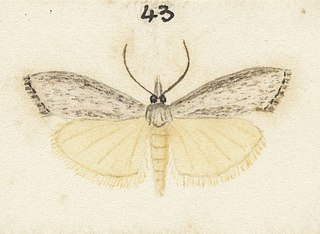
Orocrambus sophronellus is a moth in the family Crambidae. This species is endemic to New Zealand. This species has been classified as Data Deficient by the Department of Conservation.

Pyrgotis transfixa is a species of moth of the family Tortricidae. It is endemic to New Zealand. It is classified as "At Risk, Naturally Uncommon" by the Department of Conservation.

Elachista eurychora is a species of moth in the family Elachistidae. This species is endemic to New Zealand and has only been collected at Paekākāriki. The habitat where the adult moth was originally collected was in rough vegetation on coastal sandhills or dunes but the collection locality has been significantly modified since that time. It has been hypothesised that the host of the larvae of this species is a grass. Adults are on the wing in March. It is classified as "Data Deficient" by the Department of Conservation.
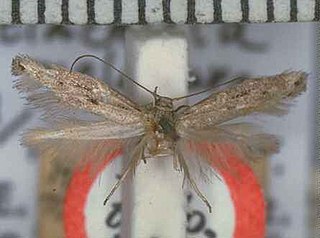
Elachista melanura is a species of moth in the family Elachistidae. This species is endemic to New Zealand. It is classified as "Data Deficient" by the Department of Conservation.

Thambotricha is a monotypic genus of moths in the family Epermeniidae. Its sole known species, Thambotricha vates, is also known by the vernacular name wonder-haired prophet. It is endemic to New Zealand. This species is classified as "At Risk, Naturally Uncommon" by the Department of Conservation.

Tinea belonota is a species of moth in the family Tineidae. It is endemic to New Zealand. It is classified as not threatened by the Department of Conservation.
Zelleria sphenota is a species of moth in the family Yponomeutidae. This species is endemic to New Zealand. It is classified as "At Risk, Declining'" by the Department of Conservation.

Hierodoris stella is a species of moth in the family Oecophoridae. This species is endemic to New Zealand and occurs in Auckland, Taranaki, Hawkes Bay, Bay of Plenty and Wellington. As at 2005 the larvae of this species is unknown as is its host plant. The adult moth frequents forest and are on the wing in January and February. It is classified as "At Risk, Relict'" by the Department of Conservation.
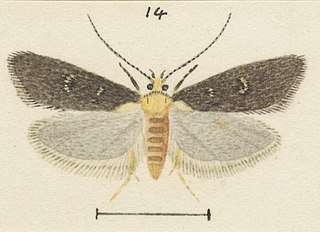
Trachypepla cyphonias is a species of moth in the family Oecophoridae. It is endemic to New Zealand and has been collected in Wellington and Taranaki. Larvae of this species have been reared from kānuka leaf litter. Adults are on the wing in December. This species is classified as "At Risk, Naturally Uncommon" by the Department of Conservation.

Lathicrossa prophetica is a species of moth of the family Oecophoridae. It is endemic to New Zealand and has been found in both the North and South Islands. This species inhabits sub-alpine native forest and adults are on the wing in January. It is classified as "Data Deficient" by the Department of Conservation.
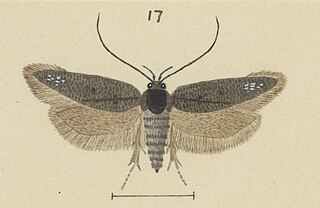
Gymnobathra origenes is a species of moth in the family Oecophoridae. This species is in need of taxonomic revision and it has been hypothesised that it belongs to the family Gelechiidae. The species is endemic to New Zealand. It has been classified as Data Deficient by the Department of Conservation. This species is known from only one specimen.
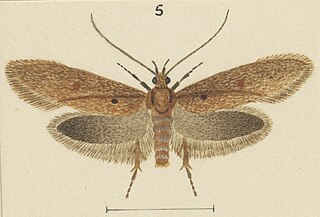
Leptocroca xyrias is a species of moth in the family Oecophoridae. The taxonomy of this species is in need of revision and L. xyrias likely belongs to a separate genus. It is endemic to New Zealand. It has been classified as Data Deficient by the Department of Conservation.
